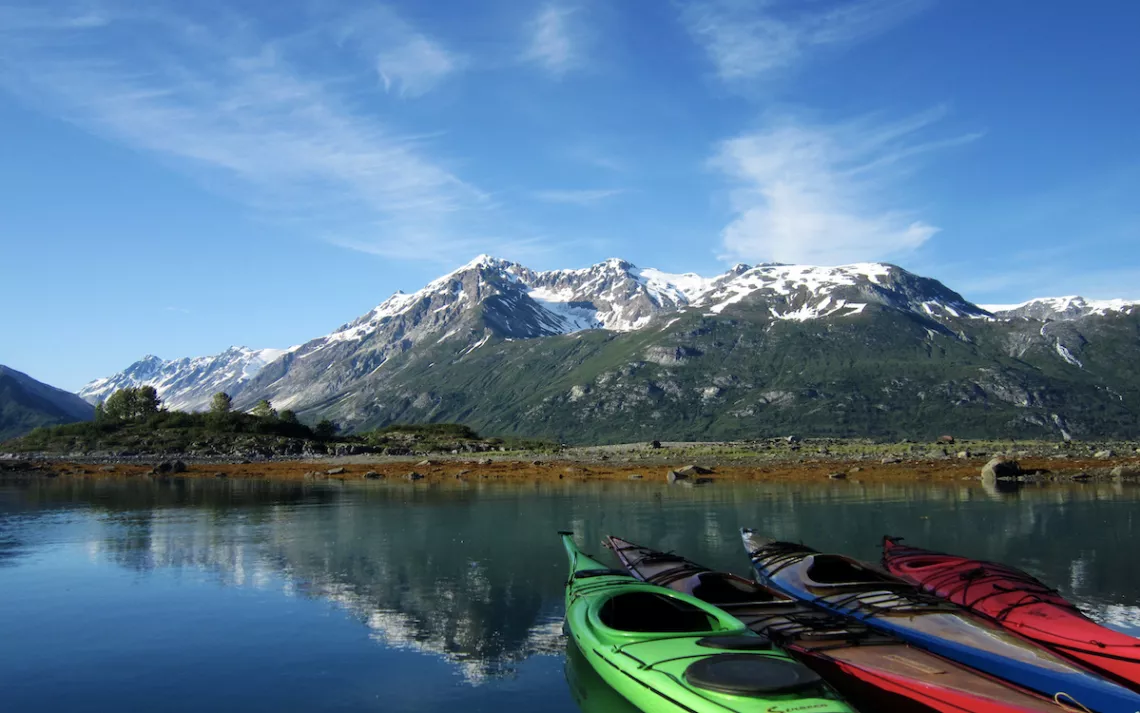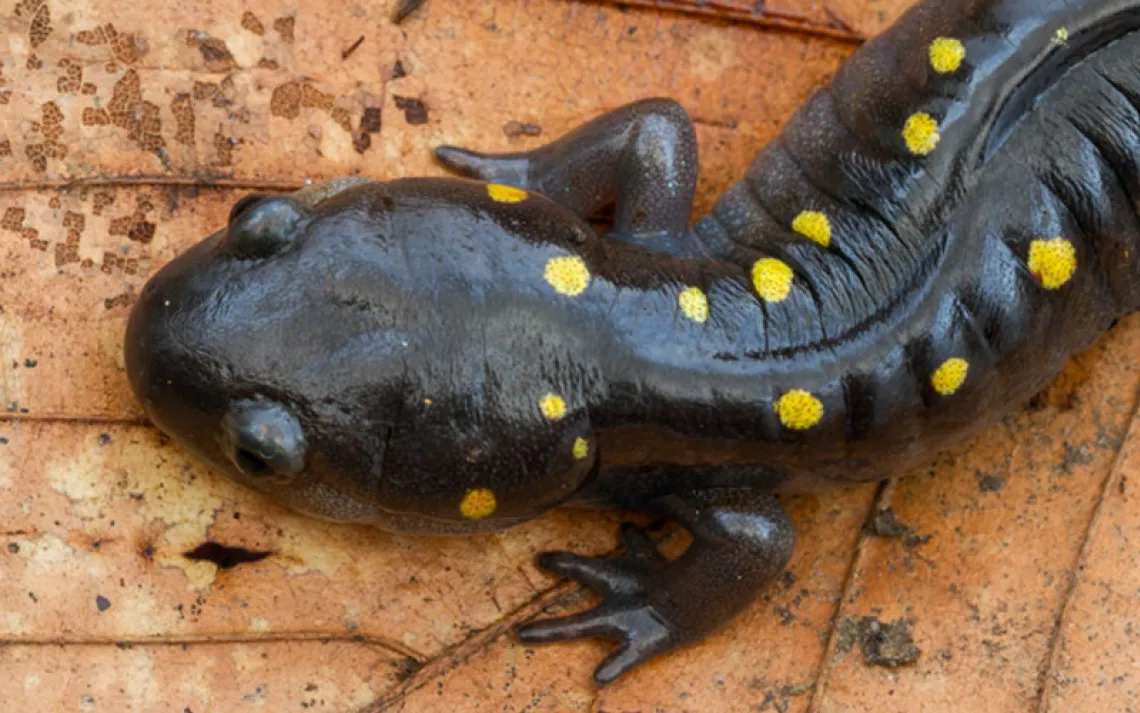The Bear
A chance encounter recalls the truth of an ancient relationship

Photos by Brian Buma
From here, the world is all perpendicular lines and right angles. The water is almost flat, gently touching on the horizontal strata of the beach—all boulders, cobbles, and gray sand. The wrack line, streaks of red seaweed marooned at high tide like striped banners, lays parallel to the small waves. Up farther, light-gray glacial silt in the cracks of rocks blends into a thin, parallel verge of grasses and trailing strawberry plants. Behind them, vertical trees in dark green, row after row. Farther still, mountains. In the low, flat space between the trees and water, pacing wildlife has compressed the ground into a trail. It is narrow, a foot wide, and distinct, hundreds of convoluted miles around bays and creeks, tracing the contour of the coast, like a necklace one foot above high tide.
Quietly warming coffee, I start preparing a morning meal of oats, dried pineapple, and nuts prior to our work: documenting how remote ecosystems grow, from a birth when the land emerges from the ice and sea to a sort of maturity, with proud spruce trees 200 feet tall, mossy understory, and logs brimming with mushrooms and lichen. We are here to observe the wild lands, to investigate and then quietly leave.
As the sun peaks over Mt. Wright, a squat 5,000 peak to the east, a dark shape coalesces along the treeline down bay, about 250 yards away. From my spot on the shore, tucked on a tall piece of driftwood, I can make out a broad, dark arch, like a smoothed outcrop of bedrock covered in moss: Ursos arctos, known as the grizzly across most of the continent and simply as the brown bear on the Alaskan coast.
The bears of Southeast Alaska are among the largest. Males can grow over 1,000 pounds and stand nine feet tall. Their paths around the bay are built over decades—each generation stepping in the footsteps of those before it, pressing down the moss and soil in dinnerplate-size impressions. The bears here embody deep history; they claim the polar bear, the world’s largest terrestrial carnivore, in their family tree. When the great Cordilleran Ice Sheet towered along the Pacific coast over 10,000 years ago, polar mothers hunted from that ice. As the world warmed, they lost ground to browns. In that transitional time, female polar bears occasionally mated with male browns, leaving their genetic footprints on the local population; roughly 7 percent of their X chromosome is Ursus maritimus. Today, these mixes dominate the region and the “ABC Islands” that front the mouth of Glacier Bay: Admiralty, Baranoff, and Chichagof Islands, better known to the bears by their Indigenous names, Xootsnoowú, Sheet’-ká X'áat'l, and Shee Kaax.

It is still quiet. Lewis Sharman emerges from his tent. Tall, rail thin, and grizzled, Lewis has lived at the mouth of the bay for decades. Though we’ve had several days without a sighting, the densest population of brown bears in the world (one per square mile, by some accounts) are found around here; Xootsnoowú itself is roughly translated as “fortress of the bear.”
Grown from amazingly prolific populations of fish, berries, and insects, they are not particularly jealous landlords, but still the best strategy for coexistence is noise: voices, conversations, and songs. After thousands of years and untold generations living together and interacting on these shores, the local culture bearers might tell you that their language, the breathy but punctuated sounds of Tlingit, is understood by the woods as easily as breathing. The sound of Tlingit is as natural here as ice falls, and perhaps the bears know it: “Bears are like people; you can talk to them,” said a Yakutat elder a few years back.
Lewis and I watch in silence. Bears have eyesight similar to humans', but in the low sunlight we are probably hidden in the up-bay haze. Their sense of smell has no such handicap. With noses over 2,000 times stronger than ours, bears scent their world for over two miles around.
Suddenly moving, the bear raises its head high and lunges into the air, lifting its front legs slightly off the ground. The breeze has shifted. Black nose poking six feet into the air, it swings its head slowly from side to side, investigating. Settling back down, it pauses, then slowly starts rambling up the cobblestone beach in our direction. Our small intrusion has piqued its curiosity.
Still a long, safe distance away, we sip coffee and watch. The 800-pound animal looks relaxed enough to nap, sagging heavy eyelids seemingly ready to take the whole body down with them.
The bear keeps moving though, slowing wandering in our direction. It lazily moves toward us, closing the distance slowly but intentionally, and eventually we must engage. At about 100 yards, within earshot, we start talking directly to it, complementing its size and the beautiful landscape. Calm words and polite speech are important in the wilderness. Anatolli Kamenskii, a Russian archbishop stationed in Alaska in the 19th century, wrote: “When [a Tlingit man] goes to the woods and is afraid of meeting a bear he tries his best to placate it with praises and affectionate nicknames … if one begins to scold the bear and to laugh at it, he can make the bear angry and bring his misfortune upon himself, since the bear cannot only understand human speech but can scent the approach of enemies and unfriendly people from a great distance.” So we speak assurances and do not laugh, but the bear continues closer, 50 yards and closing—quietly and nonaggressively, but closing.
I move to block the open cans and breakfast; Lewis covers the sealed food canister cache off to the side. Walking casually while 35 yards from an 800-pound brown bear is an exercise in concentration, but Lewis is no stranger to the woods. He slides over, always fully facing the animal, off the beach and onto the trail. Stepping parallel to the bear now, but in the opposite direction and farther from the water, he closes the gap in the trees that hides the cans. Planting his dark-green-clad frame between the spruces, Lewis effects a pose of casual calm, slightly frowning, as if waiting for a late bus.
Body language is everything. Despite their size and impressive weaponry, brown bears prefer ritualized postures and movements to actual fighting. The process begins with a yawning motion, showing teeth, which then builds into huffing noises, popping of jaws, and sharp head gestures. Slapping the ground and bluff charges cap the display before things turn violent. You must respond appropriately in this dance. Broad shoulders and size matter. Turning one's back on a bear is unwise; running is plain foolish. But nothing in the body language suggests aggression or even much interest—except for the fact that the bear refuses to deviate from its path, neither taking the low road along the waterline or the high road along the wildlife trail.
Thirty yards out, the bear passes by Lewis, as casual as a window-shopping tourist. At this point, the bear and I are in an earnest but one-sided conversation. According to the Yakutat, the proper tone when talking with a bear is deference; the first recommended words on encountering a brown bear are ‘ican xat, meaning “pity me,” and then to state your relationship, as the Tlingit and bears are related, either as brothers, brothers-in-law, father, or siblings in some fashion. ‘Ican xat ‘ax ‘ic thlen; “Pity me, my big father.” This reminds the animal of a deep relationship, of identity and origin with this place, and they will leave. Perhaps that is so. But I do not speak Tlingit, and maybe it is English the bears do not recognize.
At 20 yards, I step toward it and up onto a large, weather-beaten gray driftwood log in an effort to appear larger. Balancing in my brown rubber boots on the splintered wood, right leg jittering slightly, I look down from nine feet up. But the bear is not impressed; on its hind legs, we would stand nose to snout. I wouldn’t be impressed either.
Fifteen yards. Then seven. Quick movements are unwise; instead, one must attempt calm thoughts and predictable movements. We do not have a gun this trip, just bear spray—though that is perhaps for the best. According to elders, bears can understand what you think as well as say. Yet there is still no sign of aggression, no clear need to be defensive; the bear is closer now, more present and engaged—but that is all.
At about four yards away, the bear stops. A deep sigh of morning laziness rises from the ground. Scratching around a bit with its enormous right front paw, it casually pushes a basketball-size rock to the right, cants its hips slightly to the left, and settles, slouching slowly onto the ground. The long front claws interlace. Gently, bear rests its head on its paws, nose tilted slightly down. The brown mountain cocks its eyes up and stares at me like a large, unkempt brown dog, laying patiently by a fire, looking up out of its baggy eyes at the world walking by.
It visibly relaxes, content in place.
“You’ve got to be kidding,” says Lewis from off to the side, not breaking verbal stride. Staring down at the immense animal, my response is in the same flat tone. “Maybe it doesn’t know what we are?” “Maybe, though people do get back here occasionally.” But not often, and not on land. Kayaks are rare. Most of the few people who do pass within shouting distance of shore are on those floating islands smelling of diesel, or perhaps gliding silently with sails shaped like the mountains. They are not walking on two legs.
Is there an ancestral memory in bears? A recognition of humanity as a cohabitant, a compatriot of this landscape? It is difficult to tell. Languid, liquid brown eyes stare up at me; a small fly walks above the bear's right eyebrow. Just a few paces apart, I smell the fur and hear every breath, observe the rise and fall of the chest, note where one claw on the left front paw is chipped off short and jagged. Head resting patiently, the bear stirs only briefly to brush at the fly with the back of its paw as it continues to quietly look.
Looking into the eyes of an adult brown bear is not recommended; it can be like issuing a challenge over dominance. But now we are watching each other breathe, monopolizing the visual space of each other. It is oddly intimate. Deep brown and slightly watery, the color is wet soil on the edge of a shaded stream rich with tannins and organic matter. The morning sky reflects in bright, milky-blue pinpricks the color of calving ice. Small for the face, but large because of sheer scale, each blink is slow and deliberate. There is no hint of a threat in those eyes, just quiet, and perhaps curious, observation.
Even at some deep, animalistic level, the lizard brain level, I feel surprisingly calm, though the jittering in my right leg continues, an independent but removed sign that my body knows it’s in the presence of a large predator. Nothing in the situation suggests threat, though of course threats exist; the bear is as still and sedate as the glaciers in the background. A ridiculous thought comes into my head: I have the complete conviction I could climb down and stroke the enormous head. Even now, telling this story later, I still do.
How long we stood there, I honestly don't know.
“Wilderness is not a luxury but a necessity of the human spirit, and as vital to our lives as water and good bread,” Ed Abbey wrote. “A civilization which destroys what little remains of the wild, the spare, the original, is cutting itself off from its origins and betraying the principle of civilization itself.” We of course need to see the wilderness. Maybe, sometimes, the wilderness feels the same toward us.
Sometime later, at the appropriate time, the bear shifts its attention. Levering slowly up, hind legs first, it lumbers up to the trail and continues north, slowly and without looking back. Just like that, my time is up. It was only curiosity, a self-assessment perhaps. A questioning exploration, though by whom is unclear. A deep breath to steady the legs, then I step off the log. Lewis and I pick up our cold coffee and refill the water on the stove.
 The Magazine of The Sierra Club
The Magazine of The Sierra Club



